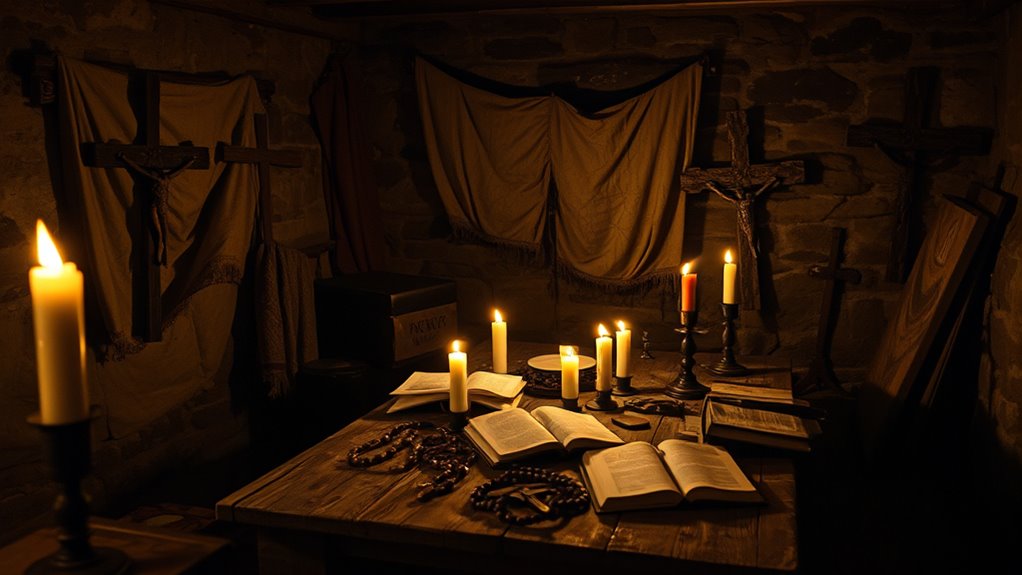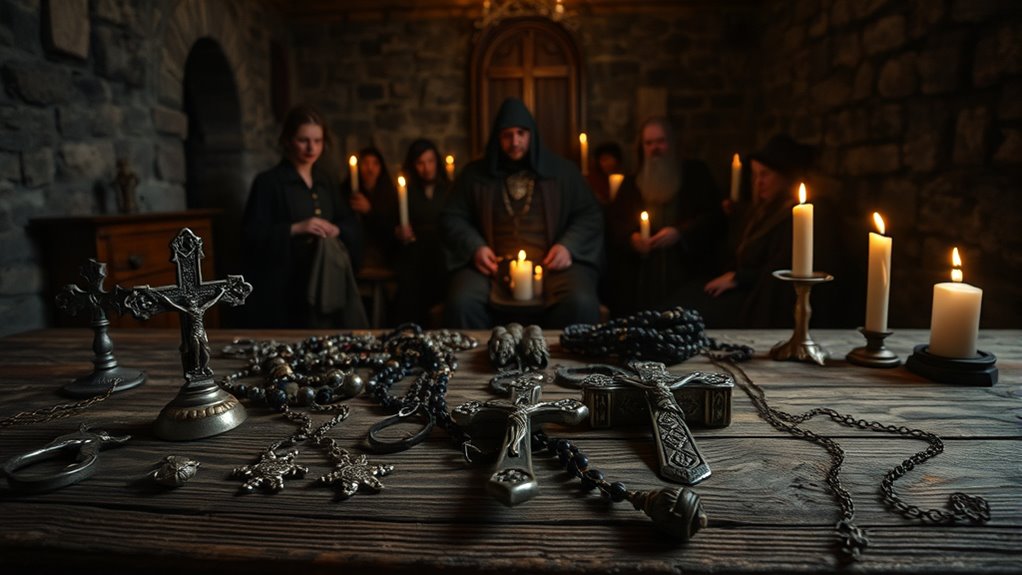In 1634, the possessions at Loudun reveal how religious fervor, political tension, and societal fears fueled mass hysteria in 17th-century France. Nuns displayed strange behaviors, promising a demonic invasion that led to exorcisms, accusations, and societal chaos. These events challenged church authority and exposed the fragile links between faith, paranoia, and power. Exploring more can uncover how this crisis shaped societal views on morality, authority, and the supernatural during that era.
Key Takeaways
- The Loudun possessions involved nuns exhibiting physical and psychological symptoms linked to demonic influence, causing social unrest.
- Religious authorities performed exorcisms, using rituals like prayer and holy water to expel supposed demons.
- Accusations were fueled by societal fears, religious fervor, and political tensions, reflecting medieval superstitions.
- The events challenged authority, sparking debates on faith, psychology, and the legitimacy of spiritual possessions.
- The case exemplifies 17th-century beliefs linking demonic possession to moral and social failures within a deeply religious context.
The Historical Context of 17th Century France

In 17th century France, the political landscape was marked by absolute monarchy, with King Louis XIII and later Louis XIV consolidating power and centralizing authority. During this period, medieval traditions still influenced society, blending old customs with new royal policies. The monarchy issued royal decrees to reinforce control, often emphasizing divine right and social hierarchy. These decrees dictated laws, religious practices, and social norms, shaping daily life across France. As a subject, you’d see the king’s authority reflected in laws that upheld traditional values while expanding royal power. The church also played a significant role, supporting the monarchy’s influence and maintaining medieval religious customs. This atmosphere of centralized authority and tradition set the stage for events like the Loudun possessions, rooted in societal and religious tensions of the era. Additionally, centralized authority reinforced the societal structure that contributed to the hysteria surrounding the possessions. The religious authorities often collaborated with the monarchy, further entrenching this control over societal beliefs and practices. Furthermore, the intertwining of religion and politics heightened the societal tensions that fueled the hysteria, as religious conflicts and political power struggles often overlapped during this period. This interconnectedness created a fertile ground for superstitions and fears, which played a crucial role in the events of Loudun.
The Enigmatic Convent of Loudun

The convent of Loudun, a focal point of religious and social tension, stands as a symbol of the complex interplay between faith and authority in 17th-century France. Its medieval architecture reflects the era’s religious fervor, with thick stone walls and narrow windows designed for both defense and contemplation. As a convent, it embodies traditional convent architecture, featuring cloisters, chapels, and living quarters that fostered spiritual life and community. The structure’s enigmatic nature comes from its history of unrest, alleged demonic possessions, and political intrigue. Its imposing presence underscores the power struggles between church authorities and local populations. By understanding the convent’s architecture and historical significance, you gain insight into the social fabric and religious tensions that defined Loudun’s turbulent history. Additionally, the events at Loudun have been studied as an example of how demonic possessions can reflect societal anxieties of the period, highlighting the importance of social dynamics in historical interpretations. Furthermore, the religious fervor of the time greatly contributed to the intense reactions and accusations that fueled the unrest. The tension between religious authority and local communities played a crucial role in shaping the events that unfolded within and around the convent. Recognizing the influence of home decor and cultural expressions of the period can provide a broader understanding of how societal tensions were visually and materially manifested.
The First Signs of Unrest Among the Nuns

As tensions within the Loudun convent started to surface, subtle signs of unrest among the nuns became increasingly difficult to ignore. Many exhibited strange behaviors rooted in medieval superstitions, such as trembling, crying out, or convulsing without clear cause. You might notice their sudden withdrawal from prayer or community activities, hinting at underlying nun psychological distress. Some nuns claimed to see visions or hear voices, which they attributed to demonic influences, fueling fears of possession. These early signs weren’t outright accusations but reflected a collective unease and confusion. The combination of deep-rooted superstitions and growing mental strain created an environment ripe for suspicion. You could sense that something more sinister was brewing beneath their outward calm, signaling the beginning of a troubling upheaval within the convent. Additionally, reports of physical ailments and inexplicable movements further indicated psychological distress, and understanding the mental health context can shed light on these behaviors, contributing to the mounting hysteria. An awareness of superstition and belief systems at the time helps contextualize their fears and reactions. Furthermore, the pervasive influence of AI in entertainment during this era might seem unrelated but underscores how societal perceptions of unseen forces shape collective responses, highlighting the importance of cultural narratives in shaping perceptions of demonic possession.
Accusations and Allegations of Demonic Possession

You’ll see how eyewitness testimonies played a vital role in shaping the accusations, often fueling suspicions. Rituals and confessions reveal the tense atmosphere and the community’s response to alleged possession. Understanding the social and religious context helps you grasp why these claims sparked widespread panic and controversy. Additionally, the influence of popular culture at the time may have contributed to the fervor surrounding these accusations.
Eyewitness Testimonies
What did witnesses actually see and hear during the alleged possessions in Loudun? You might have observed women writhing uncontrollably, shouting in unfamiliar voices, or exhibiting strange gestures. Some reports describe objects moving on their own or unexplained sounds echoing through the convent. These vivid accounts reflect medieval superstitions about demonic forces invading human bodies. Yet, modern psychologists offer psychological explanations, suggesting hysteria or mass suggestion fueled the events. Witnesses often believed they saw genuine signs of possession, but their perceptions could have been influenced by fear, social pressure, or deeply ingrained beliefs. Whether supernatural or psychological, these testimonies shaped the hysteria that gripped Loudun and fueled accusations of demonic activity.
Rituals and Confessions
During the Loudun possessions, the testimonies shifted from mere observations to active confessions and accusations of demonic influence. You see, during this period, medieval rituals and confessional practices played a central role in uncovering supposed demonic activity. People believed that confessions could reveal the truth about possession, often involving detailed accounts of demonic encounters. Accusers and accused alike engaged in confessional rituals that aimed to expose or deny demonic influence. These rituals often involved intense questioning and the recitation of prayers, which were thought to purify the soul and reveal concealed evil. As testimonies grew more elaborate, confessions became a vital tool for authorities to justify accusations, even as they blurred the line between genuine possession and hysteria rooted in religious and social fears.
Social and Religious Context
How did social and religious beliefs influence the accusations of demonic possession during the Loudun episodes? During this time, deeply rooted in medieval rituals and the strict ecclesiastical hierarchy, accusations reflected societal fears and religious authority. People believed demonic forces targeted the vulnerable, especially women and those in religious communities, making accusations easier to justify. The church’s hierarchy played an essential role, framing possessions as spiritual battles that required divine intervention. These beliefs reinforced the idea that possession was a sign of moral failure or heresy, leading authorities to pursue confessions and punishments. Social tensions and religious authority intertwined, creating an environment where accusations of demonic possession served as both spiritual warnings and tools to control behavior and maintain order.
The Role of Religious Authorities and Exorcisms

Religious authorities played a central role in addressing the possessions at Loudun by conducting exorcisms, which they believed were necessary to confront and eliminate demonic influences. They based their actions on medieval superstitions that linked possession to evil spirits infiltrating the body. Exorcism rituals became a crucial part of their response, involving prayer, holy water, and commands to the demon to depart. These rituals aimed to purify the affected individuals and restore spiritual order. Authorities saw exorcisms as divine interventions, legitimated by church doctrine, and often held public ceremonies to demonstrate their power over demons. Their involvement reinforced the church’s authority and shaped how society understood and responded to spiritual crises like the Loudun possessions.
Political and Social Tensions Amplifying the Crisis

As political and social tensions rise, you can see how religious conflicts become more heated and unpredictable. The community’s unrest spreads beyond spiritual matters, fueling distrust and chaos. This escalation makes the crisis at Loudun even more difficult to resolve.
Religious Conflict Intensifies
The tensions surrounding the possessions at Loudun quickly escalated as political and social conflicts intertwined with the religious chaos. Religious fervor fueled accusations, and fears of witch hunts intensified as people believed demons threatened the moral fabric of society. Authorities and locals alike saw the possessions as a sign of divine punishment, prompting harsher measures. The church’s authority was challenged, and suspicion grew toward those seen as enemies of faith. Confessions of demonic activity became weapons in broader struggles for influence, and the line between genuine belief and political manipulation blurred. As the crisis deepened, religious conflict became more polarized, with accusations and persecutions spreading beyond the initial cases, turning the possessions into a symbol of broader societal and spiritual battles.
Social Unrest Escalates
As fears of demonic influence spread through Loudun, social unrest began to spiral out of control, feeding into the mounting political tensions. People, desperate to understand the chaos, relied on medieval medicine and rural superstition, which often blamed witches and demons for misfortune. Rumors and accusations fueled mistrust among neighbors and authorities, deepening divisions within the community. The townspeople’s suspicions grew, leading to protests and violent clashes, as many believed that spiritual forces threatened their safety. Authorities struggled to maintain order, but the pervasive superstitions made rational discussion difficult. The crisis became a cycle of fear and misunderstanding, escalating unrest and further entrenching social and political tensions in Loudun.
The Aftermath and Impact of the Loudun Possessions

The Loudun possessions left a profound mark on both the community and the wider society, inspiring intense debates about faith, psychology, and authority. In the aftermath, secular perspectives emerged, questioning the supernatural explanations and emphasizing psychological or social causes. Modern interpretations often see the events as a complex mix of mass hysteria, political manipulation, and personal vendettas. This case challenged traditional authority, prompting skepticism about church power and spiritual claims. The scandal influenced legal and medical fields, encouraging investigations into mental health and social influences behind such phenomena. Overall, the Loudun possessions became a turning point, shaping future discourse on mass hysteria, religious authority, and the limits of human understanding, with lasting implications for how society interprets similar events today.
Broader Implications for Society and Faith

The Loudun possessions profoundly challenged societal and religious norms, forcing communities to reconsider the power of faith and authority. They exposed how medieval superstition could intertwine with religious beliefs, blurring the line between genuine faith and paranoia. As skepticism grew, people questioned whether these possessions were divine or driven by hysteria. This crisis pushed society to reevaluate its understanding of spiritual authority, leading to increased suspicion of clergy and institutions. Visualize:
- A town where whispers of demons ignite fear and suspicion.
- Religious leaders debating whether faith or superstition fuels the chaos.
- Citizens torn between trusting their faith and doubting their beliefs amid chaos.
These events forced society to confront the limits of faith, highlighting how superstition and skepticism can collide, ultimately reshaping perceptions of divine authority and human morality.
Frequently Asked Questions
What Specific Symptoms Did the Nuns Exhibit During Their Possessions?
You notice that during their possessions, the nuns exhibit specific symptoms like physical convulsions and auditory hallucinations. These involuntary movements often appear suddenly and intensely, while they also report hearing voices or noises that aren’t there. Such symptoms can seem alarming, but they were interpreted as signs of demonic influence at the time. These behaviors made the possessions seem real and frightening to those around them.
How Did Local Residents Perceive the Accusations of Demonic Influence?
You might think the residents believed the accusations of demonic influence were mere superstitions, but they saw them as cosmic battles between good and evil. They trusted religious authority implicitly, viewing the possessions as divine warnings or punishments. To them, these supernatural events confirmed the existence of evil forces, reinforcing their faith and fears, and making the accusations seem not only real but essential to understanding their spiritual world.
Were Any of the Accused Nuns Formally Tried or Punished Legally?
You learn that during the Loudun possessions, some accused nuns faced legal proceedings, although formal trials were rare. Punishment procedures varied, often involving imprisonment or public penance, reflecting the era’s approach to dealing with alleged witchcraft or demonic influence. While not all accusations led to legal action, those who were tried often endured harsh punishments aimed at purging perceived evil from the community.
What Role Did Gender Dynamics Play in the Accusations and Trials?
Imagine stepping into a 17th-century courtroom, where gender power and societal expectations heavily influence accusations. Women, especially nuns, faced harsher judgment because of prevailing gender norms that saw them as more susceptible to evil or hysteria. These societal expectations fueled the hysteria, making women vulnerable to accusations. The trials reflected these biases, reinforcing gender roles and marginalizing women while giving men more authority in judging morality and deviance.
How Did the Loudun Possessions Influence Later European Exorcism Practices?
You see, the Loudun possessions markedly shaped later European exorcism practices by highlighting the importance of religious authority and rituals. In this historical context, these events influenced cultural perceptions of demonic possession and spiritual warfare. As a result, they fostered standardized exorcism procedures, emphasizing the need for clergy involvement. This cultural impact persists today, informing modern exorcism approaches and reinforcing the belief in spiritual battles within European religious traditions.
Conclusion
As you reflect on Loudun’s haunting tale, you realize how fear and faith can intertwine, turning ordinary lives into a whirlwind of chaos. Do you see how a single moment of hysteria can ripple through society, challenging beliefs and authority? The possessions remind us that beneath the surface of faith, human nature’s fears and doubts can spark unimaginable upheaval. Are we ever truly immune to the power of collective hysteria?









